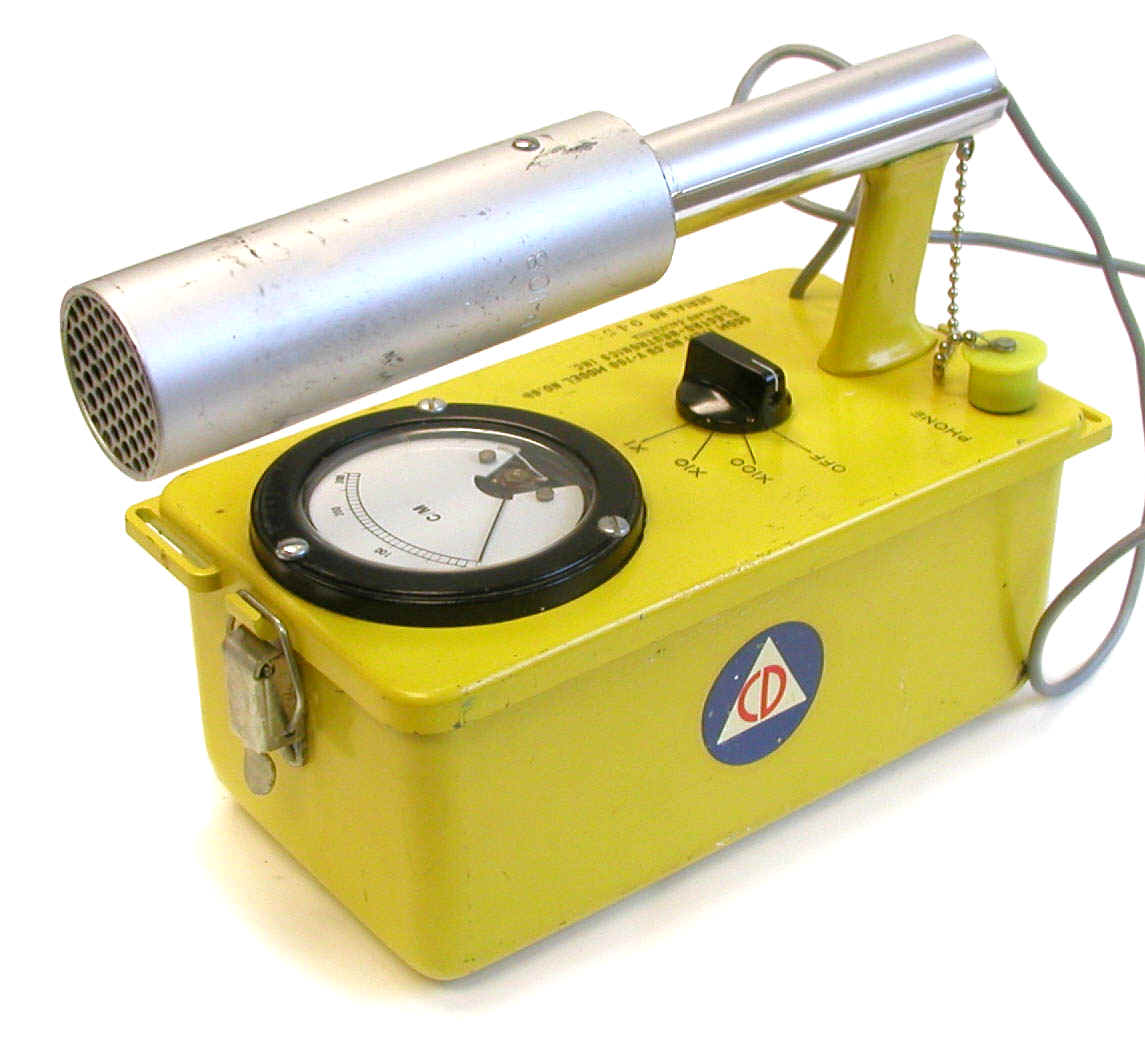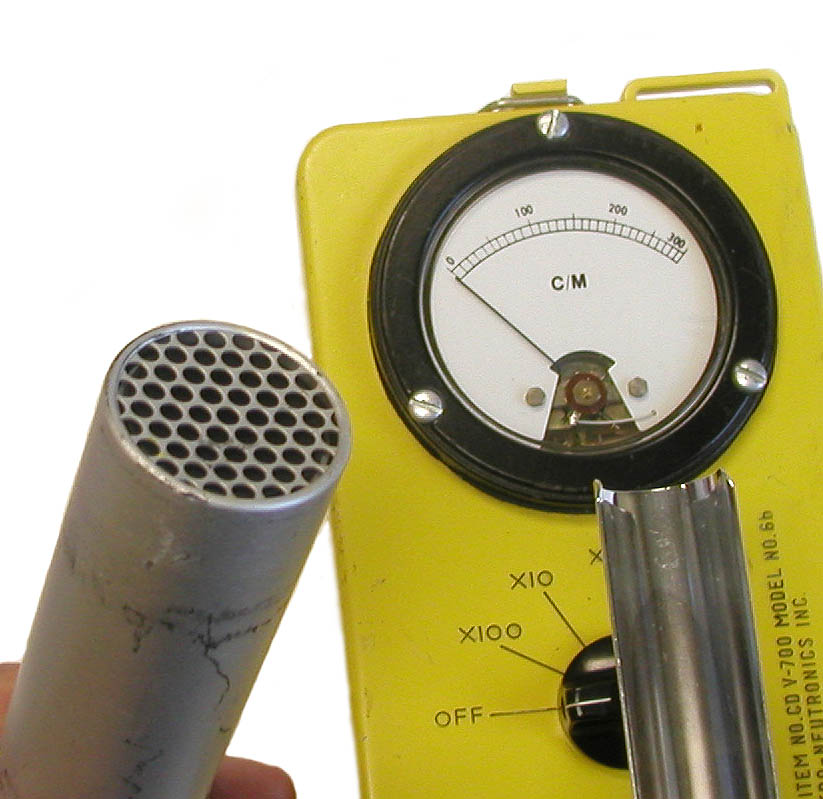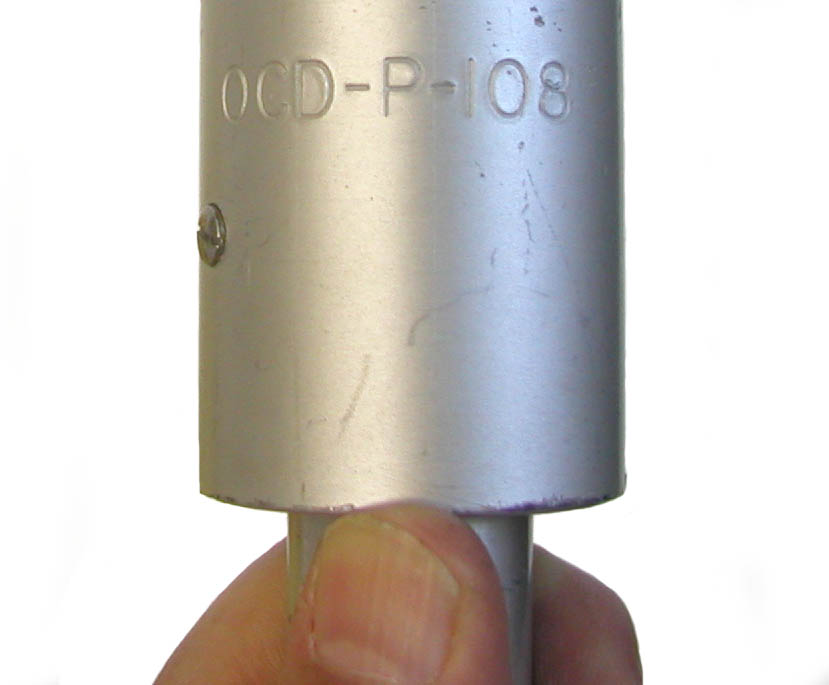CD V-700M GM Detector

The CD V-700M is a CD V-700 that has been modified to accept an end window GM tube housed in a OCD-P-108 probe. The "standard" GM tube seems to have been the Amperex 200LB (the tube in the unit shown here has a date of 6-76).
The vast majority of 700Ms are converted Electro-Neutronics Inc. Model 6bs. A few Victoreen and Lionel 6bs were also converted.
Sometime in the 1970s, the Defense Civil Preparedness Agency sent the components for this modification to the various state Radiological Instrumentation Maintenance and Calibration (RIM&C) facilities. I was told by one person who was at an RIM&C shop at that time that the parts just showed up without explanation or instructions.

The exact nature of the modification depended on whether the instrument was made by ENI or Victoreen, but it typically involved dropping the applied high voltage to match the requirements of the Amperex 200LB tube (ca. 575 volts). In some cases, the standard CD V-700 meter which reads out in both mR/hr and counts per minute was replaced by a meter that only reads out in counts per minute (see photo right).
According to FEMA's Radiological Instruments: An Essential Resource for National Preparedness, there was an existing national inventory of 300 CD V-700Ms at the time the document was published, 1986. This number was probably based on the fact that each state was given the parts to convert six CD V-700s into 700Ms.
Collectors should be aware that there are modern "knock-offs" of the 700M on the market. These knock-offs employ 900-volt LND end window tubes housed in surplus OCD-P-108 probes that are coupled to unmodified ENI meters.
The Origin of the CD V-700M

According to Marlow Stangler, who started working with the Civil Defense instrumentation program in 1962, the 700M came into being because of two specific contamination incidents. The first involved a glass radium tube left inside the case of a survey meter by a physician who had undergone civil defense training in Tennessee. Somehow, perhaps when the case was closed, the tube was broken so that the radium was spread around the inside of the unit. Later, when the instrument went to the maintenance depot, the instrument was opened up and the facility became contaminated. The other incident involved the CD V-457 classroom training sets which contain radium sources. Apparently someone made one or more of these sources out of crimped metal disks rather than plastic. The disk leaked and the set(s) became contaminated. As a result of these incidents, Stangler decided that the maintenance shops needed the capability to survey for alpha contamination. Converting a CD V-700 to use a 900-volt end window GM seemed to be the simplest solution. Apparently the 900-volt tubes did not work out and they were replaced by the lower voltage Amperex 200LB tubes. When I asked Carl Siebentritt about this, Carl was the one responsible for the Test Facility at Mount Weather, he simply said that the CD V-700M end window was for contamination surveys at the RIM&C facilities.
It is probable that an end window detector was selected for alpha contamination surveys rather than an alpha scintillator because modifying the CD V-700 circuitry to accept a ZnS probe would have been too complicated and expensive. In addition, the end window GM tube gave the CD V-700M greater sensitivity for beta contamination than the standard CD V-700 side window GM tube. In this regard, it is worth noting that for many decades the AN/PDR-27 end window GM has been the U.S. military's primary instrument for contamination surveys.
It might also be worth saying something about the comments that occasionally crop up implying that the 700M cannot detect alpha particles. This is pure nonsense. The 700M shown here has easily detected the alphas from Pu-239 and Th-230 sources. Furthermore, the Amperex specifications for the 200LB tube describe it as an alpha, beta, gamma detector. If that were not enough, read the following text from FEMA publication CPG 2-2.
Description of CD V-700M from FEMA Publication Use of Civil Defense Radiological Instruments for Peacetime Radiological Emergencies (CPG 2-2)
"Use of the CD V-700 for Alpha Emitters. The standard CD V-700 will neither detect nor measure alpha radiation. The wall of the standard CD V-700 Geiger tube is much too thick for even the most energetic alpha radiation to penetrate. A special thin window Geiger tube which will detect alpha radiation has been developed for use with certain models of CD V-700 instruments. With such a Geiger tube installed, the instrument is designated the CD V-700M. The electronic circuitry of the CD V-700M has been modified to accommodate this type of detector. The CD V-700M may be used to detect the presence of an alpha emitter but would not provide a measure of the hazard. It would also detect any beta or gamma radiation present. As is the case for beta emitters, specialized equipment and techniques are required to measure an alpha radiation hazard. Most States have a few of the CD V-700M survey meters."
The Theory that the CD V-700M was Designed for Measuring Iodine Uptake by the Thyroid
There is a common misconception that the CD V-700M was developed to evaluate iodine-131 uptake by the thyroid gland—such uptakes could be of concern following a reactor accident or a nuclear explosion. The only specific mention of this use of the 700M that I am aware of is the following brief statement in the 1986 FEMA publication Radiological Instruments: An Essential Resource for National Preparedness: "Other special requirements were identified, and appropriate instruments were designed and procured. These instruments included the CDV-700M for radioiodine measurements, the CDV-717 for remote readings..." The preponderance of the facts would lead me to conclude that this unsupported statement is simply incorrect. It is true that the 700M could be used for radioiodine uptake measurements, as could any GM detector, but that was not its intended purpose.
FEMA was certainly interested in developing a method that could be used in emergencies to estimate the amount of iodine incorporated into the thyroid, and they provided detailed information about such measurements in both the original 1980 version of the FEMA publication Guidance on Offsite Emergency Radiation Measurement Systems Phase 1—Airborne Release and its 1987 revision.
The 1980 version of the document included a table showing the response, in cpm/uCi, of various detectors to radioiodine in the thyroid. These detectors included a CD V-700 with a OCD-D-103 tube, a CD V-700 employing a Victoreen 6306 tube, an unidentified end-window GM instrument, and a Ludlum Model 44-3 gamma scintillator. The only statement in the accompanying text regarding any of these instruments is "a projected adult thyroid dose of greater than 6.5 rads can be detected with a portable side window GM instrument using this technique. However, a scintillation detector or the use of a more sensitive GM tube is required to detect a less than 65 rad projected dose to a child thyroid." The table indicated that the unidentified end-window tube had three times the sensitivity of the standard OCD-D-103 side window GM tube and that the 6306 tube had had ten times its sensitivity. The analogous table in the 1987 revision of FEMA REP-2 included the responses of a greater number of detectors to radioiodine in the thyroid: two OCD-D-103 tubes, two Victoreen 6306 tubes, a Victoreen 489-4 side window GM tube, a Victoreen gamma scintillator 489-55, an Eberline SPA-3 gamma scintillator, and an Eberline RD-22 gamma scintillator.
There are two things worth noting. First of all, even though the 1987 revision considered more detector types than the original document, it eliminated all references to the response of an end window GM tube. Second, in neither document was there a single mention of the CD V-700M. Both of these facts are incompatible with the theory that 700M would be FEMA's chosen instrument for estimating thyroid uptakes of radioiodine.
Finally, here are two additional reasons why FEMA was unlikely to have considered the CD V-700M their preferred detector for thyroid uptake measurements:
To my knowledge, no literature was provided with the 700M describing how the thyroid measurement would be performed or how the data would be interpreted. This lack of guidance would be inconceivable for such an intended application. On the other hand, the use of the 700M for surface contamination surveys would require no explanation.
The end window tube of the 700M is very easily broken. When a fragile instrument is selected for an application, it is usually the case that the instrument is necessary for that particular task. In other words, more rugged alternatives would not be available. In fact, a side-window GM tube (the Victoreen 6306) was available that was not only more rugged than the 700M's end window tube, it was also more sensitive and less expensive.
The 700M was kindly donated by the Northern Ohio Chapter of the Health Physics Society courtesy of John Wills.
References
- Marlow Stangler. Personal communication.
- Richard Faulkner. State of Nebraska. Personal communication.
- Ruben Steinmann. State of Pennsylvania. Personal communication courtesy of John Boyle.
- Amperex Nuclear Products. Catalog. No date.
- Federal Emergency Management Agency. Use of Civil Defense Radiological Instruments for Peacetime Radiological Emergencies." CPG 2-2. September 1991.
- Federal Emergency Management Agency. Radiological Instruments: An Essential Resource for National Preparedness, CPG 3-1, September. 1986.
- Federal Emergency Management Agency. Guidance on Offsite Emergency Radiation Measurement Systems Phase 1 - Airborne Release. FEMA REP-2. September 1980.
- Federal Emergency Management Agency. Guidance on Offsite Emergency Radiation Measurement Systems Phase 1 - Airborne Release. FEMA REP-2, Revision 1. July 1987.
